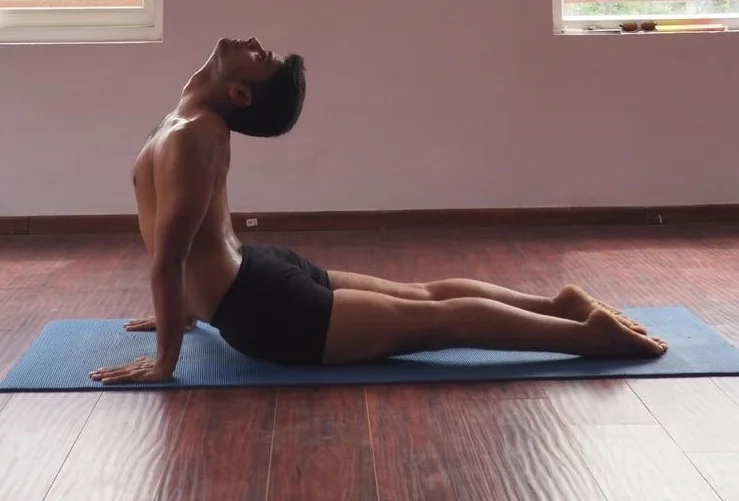Urdhva Mukha Svanasana, or Upward-Facing Dog, is a dynamic and energizing backbend that is foundational to Vinyasa and Ashtanga yoga. As a key component of Sun Salutations, this powerful pose builds upper body strength, improves posture, and opens the heart center.
The name comes from the Sanskrit Urdhva (upward), Mukha (face), and Svana(dog). Unlike the gentler Cobra Pose, Upward-Facing Dog involves lifting the thighs and hips off the mat, fully engaging the arms, core, and legs. This guide will walk you through its powerful benefits and proper alignment.
What's in this Guide:
Key Benefits of Upward-Facing Dog
Practicing this asana regularly strengthens, opens, and revitalizes both body and mind.
- Strengthens Upper Body: Builds strength in the spine, arms, shoulders, and wrists.
- Improves Posture: Counteracts the effects of slouching and prolonged sitting by strengthening back muscles and opening the chest.
- Expands the Lungs: The deep chest opening improves respiratory function and increases lung capacity.
- Boosts Energy and Focus: As a heart-opening pose, it stimulates the nervous system and improves circulation, leading to increased alertness.
- Tones the Core and Legs: Engaging the glutes and quadriceps to lift the thighs tones the lower body.
Step-by-Step Guide to Upward-Facing Dog
Proper alignment is key to receiving the benefits and preventing injury.
1. Starting Position
Begin by lying flat on your stomach, with your legs extended straight behind you and the tops of your feet resting on the mat.
2. Hand Placement
Bend your elbows and place your palms flat on the mat beside your lower ribs. Keep your elbows tucked in close to your body.
3. Lift and Open
On an inhale, press firmly through your palms to straighten your arms, lifting your chest forward and up. Simultaneously, engage your thighs and glutes to lift your hips and knees off the mat.
4. Align and Hold
Your weight should be supported only by your hands and the tops of your feet. Roll your shoulders back and down, away from your ears, to broaden your collarbones. Keep your neck long, with your gaze forward or slightly upward. Hold for 3–5 breaths.
5. Release
On an exhale either lower your body back down to the mat or use your core strength to lift your hips up and back into Downward-Facing Dog.
Watch the Pose in Action
Important Precautions
While powerful, this pose requires mindful practice. Please be cautious or avoid this pose if you have:
- Recent or chronic injuries to your back, shoulders, or wrists.
- Carpal tunnel syndrome.
- A severe headache.
- Pregnancy (deep backbends should be avoided or modified under expert guidance).
Always warm up properly before practicing and listen to your body. Never force the movement, especially in your lower back.

About the Author: Yogi Sandeep
Born in Rishikesh into a traditional family where the Vedic tradition has been a way of life for generations, Yogi Sandeep is the founder of Raj Yoga Rishikesh. He is an E-RYT 500 Teacher, holds a Master's degree in Yoga, and has over a decade of teaching experience.
Upward-Facing Dog FAQs
What is the main difference between Upward-Facing Dog and Cobra Pose?
In Cobra Pose (Bhujangasana), the hips and thighs remain on the floor, and the elbows are often kept bent. In Upward-Facing Dog (Urdhva Mukha Svanasana), the hips and thighs are lifted off the floor, with the arms fully straightened, making it a more intense and strength-building posture.
My wrists hurt in this pose. What can I do?
Ensure you are pressing down firmly through all corners of your palms, not just the heels of your hands. You can also place yoga blocks under your palms to reduce the angle of extension. Engaging your core and legs more strongly will also help lift weight out of the wrists.
How do I avoid pinching my lower back?
Focus on lengthening your spine forward and up, rather than just crunching backward. Actively engage your glutes and thighs to create support, and keep your shoulders rolled back and down to create space in your upper body.
Build Strength and Confidence in Your Practice
Mastering foundational poses like Upward-Facing Dog is key to a safe Vinyasa practice. Learn authentic alignment from expert teachers in our 200-Hour Yoga Teacher Training in Rishikesh.
Explore Our Yoga Courses →
